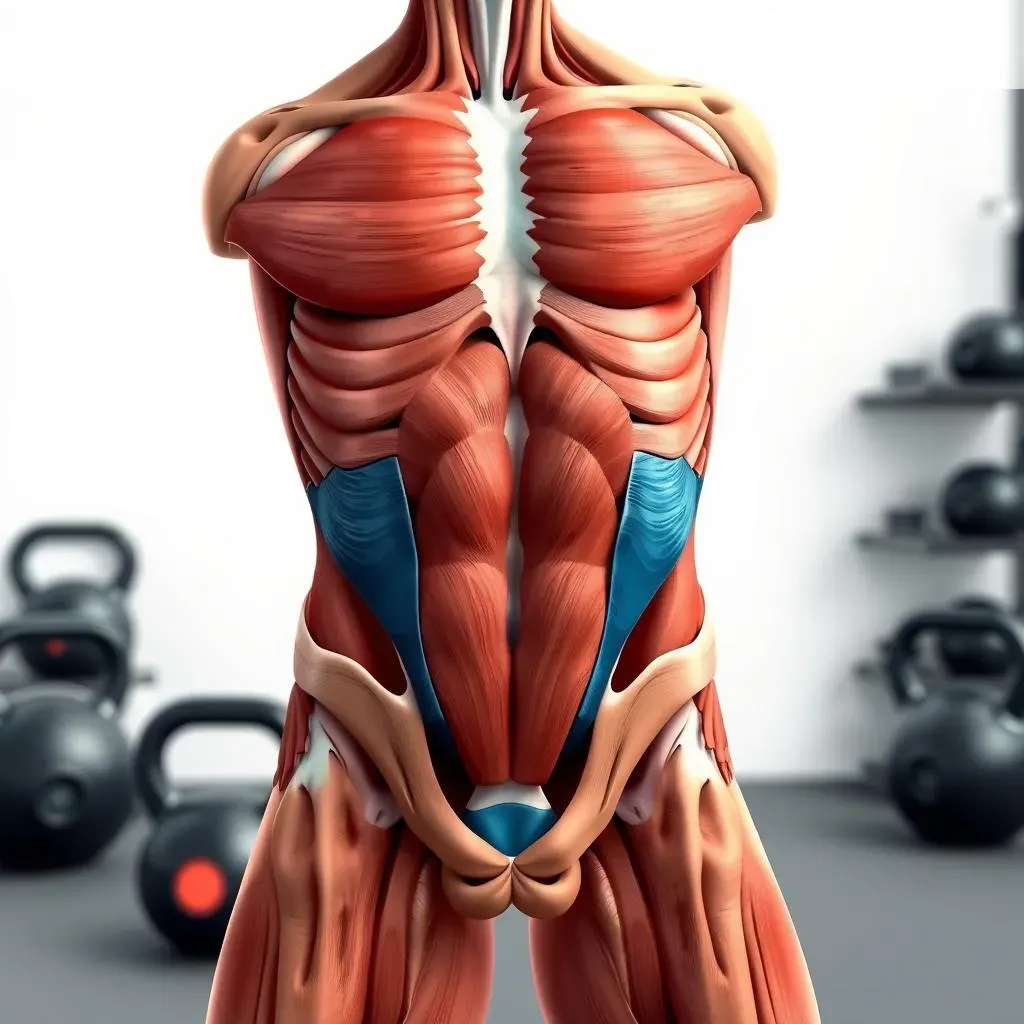Table of Contents
Ready to sculpt your dream six-pack? Forget boring crunches and tedious sit-ups! This article dives headfirst into the world of the kettlebell swing abs workout, revealing how this dynamic exercise can transform your core. We'll explore the anatomy of your abdominal muscles, ensuring you understand exactly what's being worked. Then, we'll break down the perfect kettlebell swing technique, showing you variations to challenge yourself as you progress. But the kettlebell swing is just the beginning! We'll unveil a range of additional kettlebell exercises to build total core strength and stability, creating a well-rounded workout that targets every aspect of your midsection. Finally, we'll guide you through building your own personalized kettlebell swing abs workout program, complete with progression strategies to keep you motivated and seeing results. Get ready to experience a core transformation like never before with this comprehensive guide to the ultimate kettlebell swing abs workout.
Understanding Your Core: Anatomy for a Kettlebell Swing Abs Workout

Understanding Your Core: Anatomy for a Kettlebell Swing Abs Workout
Before we even *think* about swinging a kettlebell, let's get acquainted with the magnificent muscles of your core. Think of your core as more than just your "abs"—it's a complex network of muscles working together like a well-oiled machine (or a really strong, surprisingly flexible, human machine). The rectus abdominis, those coveted "six-pack" muscles, run vertically down your stomach. They're responsible for flexion, that forward crunch movement. But they don't work alone! The transverse abdominis is a deep, corset-like muscle that wraps around your waist, acting as a natural stabilizer. It's like the foundation upon which your other core muscles build their strength. Then there are your obliques, the internal and external ones, running diagonally across your sides. They help with rotation and side bending. Ignoring these muscles is like trying to build a house without a strong foundation; it's just asking for trouble (and maybe a sore back).
Muscle Group | Primary Function | Role in Kettlebell Swings |
|---|---|---|
Rectus Abdominis | Flexion (forward bending) | Helps control the swing's upward and downward movement. |
Transverse Abdominis | Stabilization, compression | Crucial for maintaining spinal stability during the swing. |
Internal & External Obliques | Rotation, lateral flexion | Assist in controlling the swing's path and preventing twisting. |
Understanding how these muscles interact is key to performing effective kettlebell swings. A strong core isn't just about aesthetics; it's fundamental for injury prevention and overall athletic performance. It's the powerhouse that supports your movements, protecting your spine and allowing you to generate power efficiently. Think of it this way: a strong core is like having a solid base for your entire body. Without it, everything else feels wobbly and unstable. You'll find that kettlebell swings, when done correctly, will challenge and strengthen all these muscle groups simultaneously, building a resilient and powerful core.
Mastering the Kettlebell Swing: Technique and Variations for Abs

Mastering the Kettlebell Swing: Technique and Variations for Abs
The Fundamental Kettlebell Swing: Setting the Foundation
Alright, let's talk kettlebell swings. Forget those jerky, awkward movements you might have seen. The key is a powerful hip hinge, not just arm strength. Imagine you're trying to gently place a heavy suitcase on a high shelf – you wouldn’t just fling it up with your arms, right? You’d use your legs and core to generate power and control. That's the essence of a proper kettlebell swing. Start with your feet shoulder-width apart, knees slightly bent. Grab the kettlebell with an overhand grip. Keep your back straight and engage your core. Now, hinge at your hips, sending your butt back as if you're about to sit in a chair. Let the kettlebell swing between your legs. Then, using your powerful hip muscles, explosively drive the kettlebell upward, keeping your arms relatively straight and your core tight. The kettlebell should swing to roughly chest height. Control the movement as it swings back down between your legs. It’s all about controlled power and that core engagement.
Step | Action | Focus |
|---|---|---|
1 | Hip Hinge | Butt back, straight back, engaged core |
2 | Swing Down | Controlled movement, kettlebell between legs |
3 | Hip Drive | Powerful hip extension, swing up to chest height |
4 | Controlled Return | Guide the kettlebell back down, maintaining core engagement |
Adding Intensity: Variations for Advanced Core Work
Once you've mastered the basic swing, it's time to spice things up! One fantastic variation is the Russian Twist. After you swing the kettlebell up, instead of letting it swing back down, rotate your torso to one side, bringing the kettlebell close to your ribs. Then, rotate to the other side, engaging your obliques powerfully. This targets those side muscles incredibly effectively. Another excellent variation is the renegade row. Start in a plank position, holding a kettlebell in each hand. Perform a standard row with one arm, pulling the kettlebell towards your chest while maintaining a stable plank. Then switch arms. This variation builds strength and stability simultaneously, making it a killer core exercise. Remember, proper form is paramount. Don't sacrifice technique for speed or weight. Start light and focus on perfecting your form before increasing the weight or reps.
- Russian Twist: Adds rotational movement, targeting obliques.
- Renegade Row: Combines rowing with plank, enhancing stability and strength.
- Single-arm Swing: Challenges balance and unilateral strength.
Listen to Your Body: Safety First!
Finally, listen to your body. If you experience any pain, stop immediately. Start with lighter weights and gradually increase the weight as you get stronger. Remember, consistency is key. Even short, regular sessions are more effective than infrequent, intense ones. And don't forget to warm up before your workout and cool down afterward. Proper warm-up and cool-down routines prepare your muscles for the workout and help prevent injuries. A good warm-up includes dynamic stretches like arm circles, leg swings, and torso twists. A cool-down involves static stretches, holding each stretch for 20-30 seconds. A strong core is a cornerstone of overall fitness. The kettlebell swing, with its variations, offers a powerful and versatile way to achieve that strong, stable core. So, grab your kettlebell, and let’s get swinging!
Beyond the Swing: Kettlebell Exercises for Total Core Strength

Beyond the Swing: Kettlebell Exercises for Total Core Strength
Goblet Squats: Building Lower Body Strength and Core Stability
While not strictly a "swing," the goblet squat is a fantastic core exercise that complements your kettlebell swing routine beautifully. Hold a kettlebell close to your chest, like a goblet. Squat down, keeping your back straight and your core engaged. The key is to maintain a stable core throughout the movement. This forces your core to work hard to stabilize your body as you lower and raise yourself. It's a full-body movement, but the core is crucial for maintaining proper form and preventing injury. This exercise not only strengthens your legs and glutes, but also builds incredible core stability, directly supporting your kettlebell swing performance. Think of it as building a strong foundation for your entire body, improving your balance and overall strength.
- Focus on maintaining a straight back.
- Keep your core engaged throughout the entire movement.
- Control the descent and ascent to maximize core engagement.
Kettlebell Turkish Get-Ups: The King of Core Exercises
The Turkish Get-Up (TGU) is often called the king of core exercises, and for good reason. It's a full-body movement that demands incredible core stability and strength. Start by lying on your back with a kettlebell held in one hand. You'll then roll onto your side, come to your knees, then to a standing position – all while holding the kettlebell. The TGU is a complex movement that works your entire body but requires incredible core control to maintain balance and stability. It's not easy, but the benefits are immense. You'll build incredible core strength, improve balance, and enhance coordination. Think of it as a full-body test of strength and stability, pushing your core to its limits in a safe and controlled way. It's a slow, deliberate movement, and that's the beauty of it – it focuses on controlled strength and stability.
Phase | Description | Core Focus |
|---|---|---|
Lie Down | Start lying on your back with the kettlebell by your side. | Stabilization |
Roll to Side | Roll onto your side, keeping your core engaged. | Anti-rotation |
Come to Knees | Come to a kneeling position, maintaining stability. | Balance and strength |
Stand Up | Stand up, keeping the kettlebell overhead. | Full core engagement |
Building Your Kettlebell Swing Abs Workout: Programs and Progression

Building Your Kettlebell Swing Abs Workout: Programs and Progression
Crafting Your Personalized Kettlebell Swing Abs Workout
Now that you've mastered the fundamentals, it's time to create a workout plan that's tailored to your fitness level and goals. Don't just jump into heavy weights and complex variations. Start with a basic program focusing on proper form and gradually increase the intensity. A great starting point is a three-day-a-week routine. On Day 1, focus on kettlebell swings (3 sets of 10-15 reps), goblet squats (3 sets of 10-12 reps), and planks (3 sets, holding for 30-60 seconds). Day 2 could include rest or light cardio. On Day 3, incorporate Turkish get-ups (2 sets of 5 reps per side), Russian twists (3 sets of 15-20 reps per side), and renegade rows (3 sets of 8-10 reps per arm). Remember to listen to your body and adjust the program as needed. Consistency is key, so aim for a program you can stick to long-term. Don't be afraid to adjust the number of sets and reps based on your fitness level and how your body feels. Remember, progress is not always linear.
- Start with a basic program focusing on proper form.
- Gradually increase the intensity and complexity of your workouts.
- Listen to your body and adjust the program as needed.
- Focus on consistency rather than intensity.
Progressive Overload: The Key to Continuous Improvement
The secret to continuous improvement in any fitness program is progressive overload. This simply means gradually increasing the challenge over time. You can do this in several ways. One approach is to increase the weight of your kettlebell. Another is to increase the number of sets or reps you perform. A third approach is to introduce more challenging variations of the exercises. For example, you could progress from standard kettlebell swings to single-arm swings. You could also increase the difficulty of your planks by raising your legs or arms. The key is to make small, incremental increases in the challenge so your body can adapt. Don't try to do too much too soon. Remember, consistency and gradual progression are far more important than intensity. Celebrate your progress and adjust your program as you get stronger. This ongoing process of challenge and adaptation is what leads to lasting results and a stronger, more resilient core.
Week | Kettlebell Swing (reps) | Goblet Squat (reps) | Plank (seconds) |
|---|---|---|---|
1 | 10-12 | 8-10 | 30 |
2 | 12-15 | 10-12 | 45 |
3 | 15-18 | 12-15 | 60 |